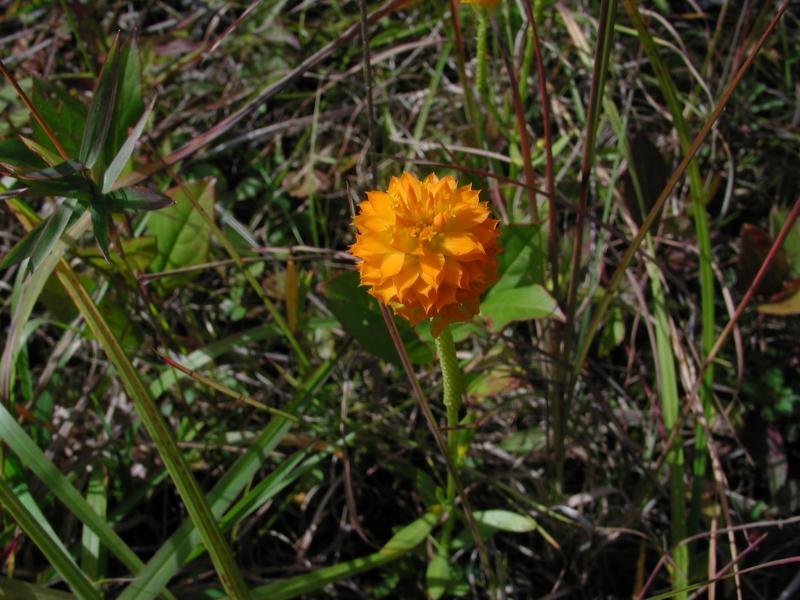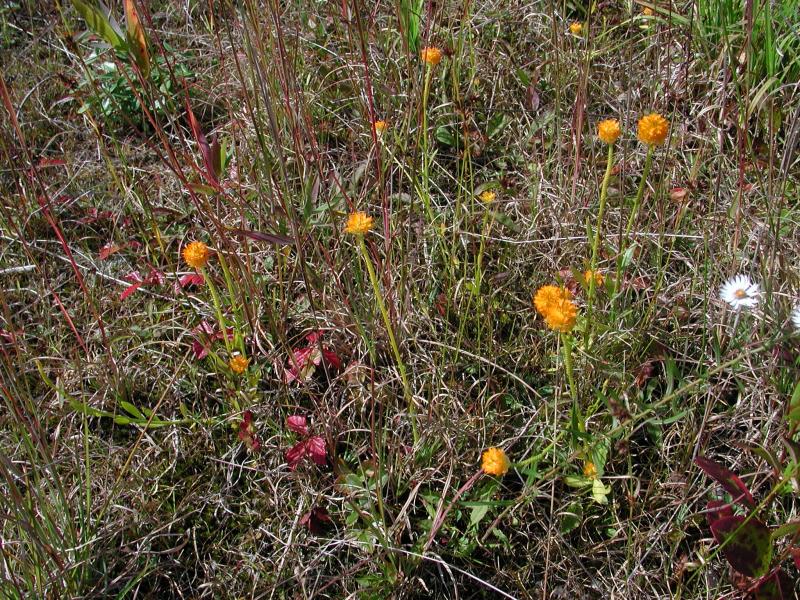Orange Milkwort
Polygala lutea L.
- Class
- Dicotyledoneae (Dicots)
- Family
- Polygalaceae (Milkwort Family)
- State Protection
- Endangered
Listed as Endangered by New York State: in imminent danger of extirpation in New York. For animals, taking, importation, transportation, or possession is prohibited, except under license or permit. For plants, removal or damage without the consent of the landowner is prohibited.
- Federal Protection
- Not Listed
- State Conservation Status Rank
- S1
Critically Imperiled in New York - Especially vulnerable to disappearing from New York due to extreme rarity or other factors; typically 5 or fewer populations or locations in New York, very few individuals, very restricted range, very few remaining acres (or miles of stream), and/or very steep declines.
- Global Conservation Status Rank
- G5
Secure globally - Common in the world; widespread and abundant (but may be rare in some parts of its range).
Summary
Did you know?
The species name of this orange-flowered wildflower means yellow because when it is dried as a specimen the flowers turn yellow. Linnaeus saw the yellow flowers when he named it from dried specimens.
State Ranking Justification
There are three existing populations but two of them are small. The largest population has over 1000 plants. There are four historical populations known from the early 1900s which need to be resurveyed. Two other populations were extirpated when their habitat was destroyed.
Short-term Trends
Plant numbers fluctuate from year to year depending upon disturbance. Recently, numbers have been reduced because of encroachment by woody plants into its habitat.
Long-term Trends
This plant has always been very rare in New York but it was once known from 9 different locations and now only survives at 3 of them.
Conservation and Management
Threats
Loss of a favorable disturbance regime from natural processes is the biggest threat to this species.
Conservation Strategies and Management Practices
Maintain disturbance regimes that optimize population numbers.
Research Needs
Research is needed to determine the best intervals and seasonality of disturbance to maintain and augment population numbers.
Habitat
Habitat
The plants occur in wet disturbed openings in pitch pine oak woods in sandy soils (New York Natural Heritage Program 2012). Sandy acidic swamps and bogs of the coastal plain (Gleason and Cronquist 1991).
Associated Ecological Communities
- Pitch pine-oak forest
(guide)
A mixed forest that typically occurs on well-drained, sandy soils of glacial outwash plains or moraines; it also occurs on thin, rocky soils of ridgetops. The dominant trees are pitch pine mixed with one or more of the following oaks: scarlet oak, white oak, red oak, or black oak.
Associated Species
- Andropogon glomeratus
- Baptisia tinctoria (wild-indigo)
- Clethra alnifolia (coastal sweet-pepperbush)
- Drosera intermedia (spatulate-leaved sundew)
- Drosera rotundifolia (round-leaved sundew)
- Epigaea repens (trailing-arbutus, mayflower)
- Eupatorium hyssopifolium (hyssop-leaved thoroughwort)
- Eurybia spectabilis (showy-aster)
- Euthamia caroliniana (slender flat-topped-goldenrod)
- Helianthemum canadense
- Juncus canadensis (Canada rush)
- Juncus dichotomous
- Panicum virgatum (switch grass)
- Pyxidanthera barbulata (pyxies, pyxie-moss)
- Rhynchospora capitellata (brownish beak sedge)
- Schizachyrium scoparium
- Scirpus cyperinus (common wool-grass)
- Scleria triglomerata (whip nut sedge)
- Viola lanceolata (lance-leaved violet)
- Viola primulifolia
- Xyris
Range
New York State Distribution
Once ranging across Long Island and Staten Island this small herb has been extirpated from its historical range except in a small area of Suffolk County. There is another old unconfirmed report from Dutchess County but it is probably in error.
Global Distribution
This is a plant of the Coastal Plains of the southeastern US from eastern Louisiana through Florida and north to southern New Jersey and Long Island.
Identification Comments
General Description
Orange milkwort is a low biennial or perennial wildflower 1-4 dm tall with stems that are often clustered together and simple or branched. The basal leaves are oblong to obovate, 2-5 cm long, with rounded tips. The stem leaves get progressively narrower and smaller. The stems terminate in a long, leafless peduncle topped by a round, dense cluster of tiny orange flowers that turn to yellow when they dry (Gleason and Cronquist 1991).
Identifying Characteristics
Distinguishing characteristics: rosette of obovate to oblong round-tipped leaves; racemes peduncled, bright orange-yellow (rarely paler yellow), becoming paler in drying; pedicels winged. Most easily identified by the bright orange to orange-yellow flowers as this is the only Polygala in New York to exhibit such a color. Best life stage for ID: in flower. Characteristics needed to ID: flowering head.
Best Life Stage for Proper Identification
The basal leaves may be hard to distinguish from other wildflowers so it is best to identify this plant when it is in flower.
Similar Species
This is the only Polygala with a round, dense cluster of small orange flowers.
Best Time to See
The plant flowers from July to early September.
- Flowering
- Fruiting
The time of year you would expect to find Orange Milkwort flowering and fruiting in New York.
Orange Milkwort Images
Taxonomy
Orange Milkwort
Polygala lutea L.
- Kingdom Plantae
- Phylum Anthophyta
- Class Dicotyledoneae
(Dicots)
- Order Polygalales
- Family Polygalaceae (Milkwort Family)
- Order Polygalales
- Class Dicotyledoneae
(Dicots)
- Phylum Anthophyta
Additional Common Names
- Bachelor's-button
- Candyweed
- Yellow Milkwort
Additional Resources
Best Identification Reference
Gleason, Henry A. and A. Cronquist. 1991. Manual of Vascular Plants of Northeastern United States and Adjacent Canada. The New York Botanical Garden, Bronx, New York. 910 pp.
Other References
Clemants, Steven and Carol Gracie. 2006. Wildflowers in the Field and Forest. A Field Guide to the Northeastern United States. Oxford University Press, New York, NY. 445 pp.
Fernald, M.L. 1950. Gray's manual of botany. 8th edition. D. Van Nostrand, New York. 1632 pp.
Holmgren, Noel. 1998. The Illustrated Companion to Gleason and Cronquist's Manual. Illustrations of the Vascular Plants of Northeastern United States and Adjacent Canada. The New York Botanical Garden, Bronx, New York.
New York Natural Heritage Program. 2010. Biotics database. New York Natural Heritage Program. New York State Department of Environmental Conservation. Albany, NY.
New York Natural Heritage Program. 2024. New York Natural Heritage Program Databases. Albany, NY.
Newcomb, Lawrence. 1977. Newcomb's Wildflower Guide: An Ingenious New Key System for Quick, Positive Field Identification of the Wildflowers, Flowering Shrubs, and Vines of Northeastern and North-Central North America. Little, Brown and Company. Boston.
Weldy, T. and D. Werier. 2010. New York flora atlas. [S.M. Landry, K.N. Campbell, and L.D. Mabe (original application development), Florida Center for Community Design and Research http://www.fccdr.usf.edu/. University of South Florida http://www.usf.edu/]. New York Flora Association http://newyork.plantatlas.usf.edu/, Albany, New York
Links
About This Guide
This guide was authored by: Stephen M. Young
Information for this guide was last updated on: September 6, 2012
Please cite this page as:
New York Natural Heritage Program. 2024.
Online Conservation Guide for
Polygala lutea.
Available from: https://guides.nynhp.org/orange-milkwort/.
Accessed July 26, 2024.

